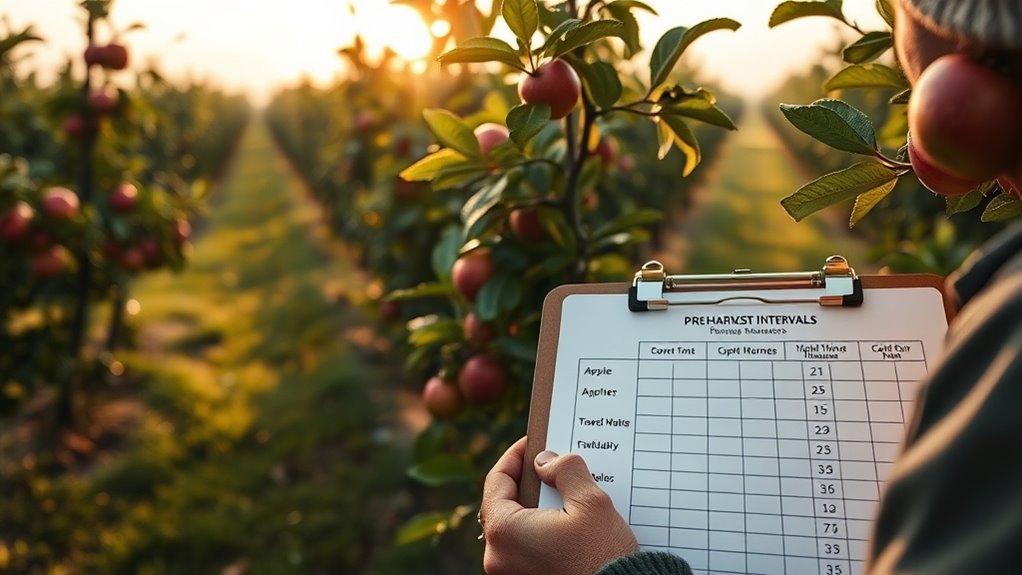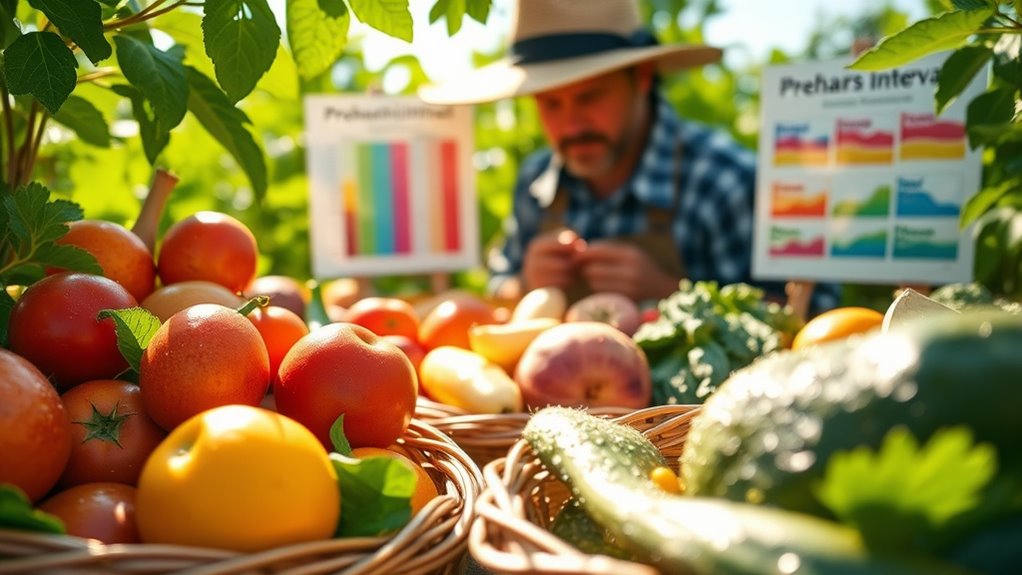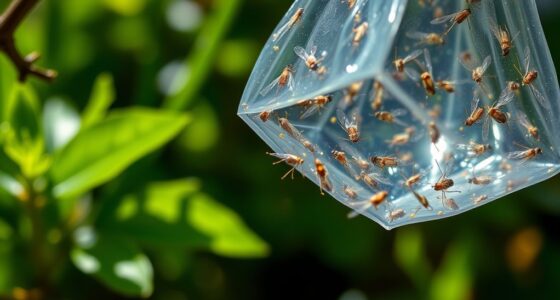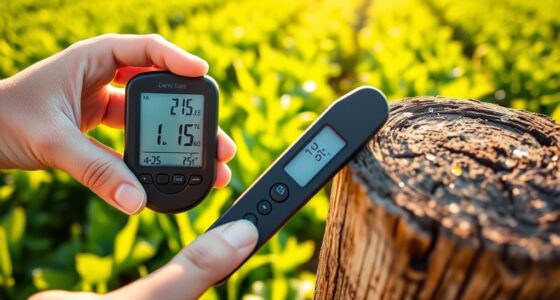Preharvest intervals (PHIs) are the minimum time you must wait between applying pesticides and harvesting your crops. They help guarantee pesticide residues break down to safe levels, protecting consumer health and regulatory compliance. Factors like pesticide type, crop, weather, and application method influence PHIs. Following these intervals prevents health risks and legal issues. If you want to learn more about how to properly time your harvest, stay tuned for detailed guidelines and best practices.
Key Takeaways
- PHIs specify the minimum time between pesticide application and harvest to ensure safe residue levels.
- Proper adherence to PHIs protects consumer health and complies with regulatory standards.
- Environmental factors like rain and humidity influence pesticide breakdown, affecting PHI durations.
- Always review pesticide labels and consult guidelines to determine correct PHIs for specific crops.
- Harvesting within the recommended PHI minimizes health risks and supports responsible farming practices.

Understanding preharvest intervals (PHIs) is vital for guaranteeing the safety of your crops and consumers. PHIs are the minimum amount of time that must pass between the application of a pesticide and the harvest of your crops. If you don’t adhere to these intervals, you risk leaving pesticide residues on your produce that may be harmful to those who consume it. Properly managing harvest timing based on PHIs helps you produce safe, high-quality crops while complying with regulatory standards and protecting consumer health.
Adhering to preharvest intervals ensures crop safety and compliance with regulatory standards.
When planning your harvest, knowing the specific PHIs for each pesticide you use is vital. These intervals are established through extensive testing to determine how long it takes for pesticide residues to break down or diminish to safe levels. If you harvest too early, pesticide residues might still be present at levels exceeding safety limits, which could pose health risks and lead to potential legal issues. Conversely, waiting too long might risk crop quality or economic loss, but it’s a necessary step to guarantee safety. Accurate harvest timing, aligned with the prescribed PHIs, minimizes the presence of pesticide residues and guarantees that your produce meets safety standards.
It’s important to remember that PHIs can vary depending on the pesticide, crop type, application method, and environmental conditions. For example, a pesticide with a short PHI may require just a few days before harvest, while others might necessitate a waiting period of a week or more. Weather factors like rain or high humidity can also influence how quickly pesticides break down, so staying informed about these variables helps you make better decisions about harvest timing. Regularly reviewing regulatory guidelines and staying updated on environmental factors can improve your harvest planning. Always review the label instructions carefully and consult extension services or regulatory guidelines to guarantee you’re following the correct PHIs.
Adhering to appropriate harvest timing based on PHIs not only safeguards consumers from potential pesticide exposure but also enhances your reputation as a responsible grower. It demonstrates your commitment to producing safe, compliant food. Regularly checking pesticide labels and maintaining detailed records of application dates and intervals can streamline this process and prevent accidental premature harvests. Remember, managing harvest timing is a proactive step that directly impacts pesticide residue levels on your crops, ensuring they are safe for consumers and compliant with food safety standards. By respecting PHIs, you protect your customers, your farm’s reputation, and your livelihood.
Frequently Asked Questions
How Do Weather Conditions Affect Preharvest Intervals?
Weather conditions considerably impact preharvest intervals. You should know humidity impact; high humidity can slow pesticide breakdown, extending the interval. Temperature fluctuations also matter; hot weather speeds chemical degradation, shortening the time needed before harvest. Keep an eye on weather patterns, as these factors influence pesticide residue levels on crops, ensuring safety and compliance with regulations. Adjust your harvest schedule accordingly to protect consumers and maintain crop quality.
Are There Differences in Preharvest Intervals for Organic Versus Conventional Farming?
Think of organic and conventional farming as two different symphonies. Organic standards often mean longer preharvest intervals to make certain safety, like letting a melody breathe. Crop rotation in organic farming can influence these intervals, requiring patience for natural detoxification. Conventional farming might have shorter intervals due to synthetic inputs. Your approach depends on balancing safety with timely harvests, respecting nature’s rhythm and the rules that protect your crops.
Can Preharvest Intervals Be Shortened Safely?
Preharvest intervals shouldn’t be shortened, as doing so risks increasing pesticide residues on your crops. Maintaining the recommended intervals guarantees safety and compliance with regulations. Farmer compliance is vital here; ignoring these guidelines can lead to unsafe pesticide residues, affecting consumer health and your reputation. Always follow the label instructions and consult with experts if uncertain, to keep your produce safe and legally compliant.
How Often Do Violations Occur Due to Incorrect Intervals?
Think of application compliance like following a recipe—skipping steps can ruin the dish. Violations due to incorrect intervals are surprisingly common, with violation statistics showing that many growers miss the mark. These mistakes often happen when preharvest intervals aren’t properly observed, leading to residue issues. Staying diligent guarantees you avoid violations, protect consumer safety, and keep your operation running smoothly. Regularly checking your intervals helps you stay on the right side of compliance.
What Agencies Enforce Preharvest Interval Regulations?
You should know that regulatory agencies like the EPA and USDA enforce preharvest interval regulations. These enforcement agencies monitor pesticide use to guarantee farmers follow the required waiting periods before harvest. They conduct inspections, review records, and issue penalties for violations. By adhering to these guidelines, you help protect food safety and ensure compliance with federal laws, reducing the risk of violations and promoting responsible pesticide use.
Conclusion
Now that you understand preharvest intervals and safety, you realize there’s more at stake than just timing. Ignoring these guidelines could lead to unexpected risks, but the true consequences might be even more surprising. Will you take the necessary steps to protect yourself and others? The choice is yours—stay informed, stay safe, and never underestimate what’s at stake when it comes to crop safety and your well-being. The next move could change everything.









